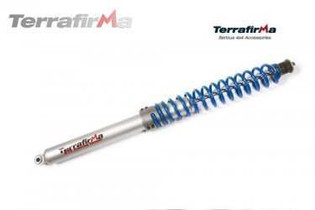It is a common misconception that fitting a wide angle propshaft will cure vibrations caused by raised suspension. The cause of the vibration is the angle of the shaft in relation to its end flanges, fitting a wide angle shaft does not change the angles. The vibration may seem reduced but this will be coincidental with a new heavier shaft in perfect condition. 20% stronger than standard Land Rover propshafts. ユ Double seal arrangement on slip coupling. ユ RILSAN coated 100mm spline slip coupling for smoother operation. ユ Metal shield greasable universal joints ユ 32 deg. wide angle yoke and joints ユ Unique gun metal grey paint. When a Land Rover is produced the angle of the propshaft in relation to the two end flanges is carefully calculated in order that the vibration inherent with universal joints* is undetectable. The universal joints at each end of a propshaft are also set out of line, out of synchronisation to control this vibration, this is known as phasing. Lifting the vehicle by raising the suspension alters the propshaft angles which often causes severe vibration. Aggressive mud tyres, noisy engine and transmission and the slower speeds associated with hard core off road vehicles usually masks the vibration and drivers often tolerate the additional drone or rattle from the shafts on overrun. A more road biased lifted Land Rover will most likely find the noise and vibration too obtrusive and will be keen to rectify it. The most effective way to eliminate vibration is to fit a propshaft with a double cardan joint** at the gearbox end. Even Land Rover found this essential on the Discovery 2. Double cardan propshafts are a successful vibration cure on vehicles lifted around 2ヤ. Beyond 2ヤ even the double cardan joint cannot always accommodate the angle without vibrating. *Universal joints working at an angle speed up and slow down during rotation. **Double cardan joints have two universal joints joined by an intermediate shaft, the joints are phased or synchronised with each other which overcomes the speeding up and slowing down of a single joint thus reducing vibration.



